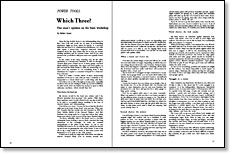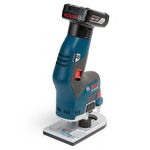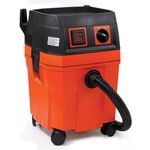
Synopsis: Robert Sutter has a workshop brimming with machines: a 10-in. tablesaw, a 13-in. thicknesser, a long-bed jointer, sanding machines, an overarm router, a drill press, and a two-spindle dowel borer. In this article, he tackles the question of which machines would he choose if he had to limit himself to three. He explains which he’d pick and why and then cheats with a fourth entry. And he’d include a box of hand tools, too.
Open the big double doors to my cabinetmaking shop in Rye, New York and you’ll see an array of woodworking machinery. Right up front, where it’s handy, is a ten-inch table saw and next to it, a thirteen-inch thicknesser. In a side aisle squats a heavy-duty, long-bed nine-inch jointer. Scattered about the shop where they fit in best are several sanding machines and an overarm router. And if you nose around a bit, you’ll find a drill press and a two-spindle dowel borer.
In the center of the shop towering over all the other machinery is a twenty-inch bandsaw. It will cut through a 13-inch thick piece of hard wood. A heavy gauge one-inch blade will fit it comfortably. The upper and lower guides on this saw hold the blade firmly to make an unwavering cut. I have used my bandsaw to cut everything from a tiny Dutchman for a repair to a monster bowsprit for a forty-two foot schooner.
Once in a while I wonder which of these sweat-saving machines I’d choose to carry with me were I suddenly to be transported to a desert island and I could bring only three. Now this is not as idle a thought as it may seem, especially for those who are just starting to build up a power workshop. In other words, if we are limited by money or space to three stationary machines, which should they be?
First choice: the band saw
My choices would be the band saw, jointer, and 6 by 48-inch industrial floor-mounted belt sander. With these three machines (and a boxful of hand tools) my aim would be to be able to accomplish almost anything in the way of classical joinery and cabinetmaking.
Now before you snort, “Doesn’t he know that the tilt-arbor table saw is the heart of any shop?” stop and ask, “Who says so?” Consider that the circular saw was invented in 1810 by Sister Tabitha Babbit of the Harvard Shakers. And fine furniture was being made for a long time before that, using frame saws which could cut wood from log to finished shape.
For those unfamiliar with it, the frame saw is a wooden rectangular frame holding a narrow blade stretched the long dimension of the rectangle. Its teeth are oriented perpendicular to the plane of the frame. To use it, one straddled the board to be cut with the saw, which was moved up and down by grasping the side of the frame. It was a big job to rip a long board—so much so that water power was harnessed to it as early as the 17th century.
From Fine Woodworking #1
For the full article, download the PDF below:
Fine Woodworking Recommended Products

Bosch 12V Trim Router

Fein Turbo II HEPA Wet/Dry Dust Extractor

Ridgid EB4424 Oscillating Spindle/Belt Sander




















Log in or create an account to post a comment.
Sign up Log in